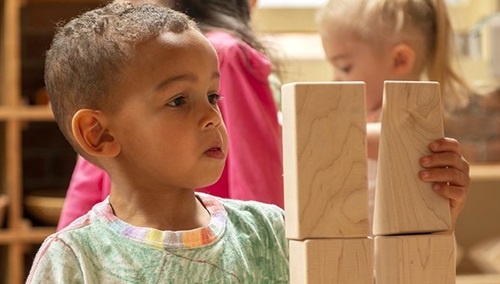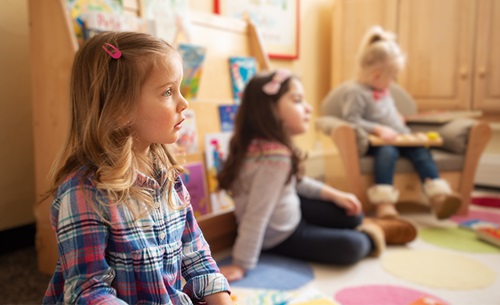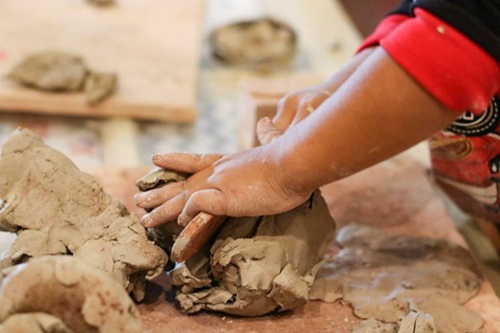Play: The Foundation of Children's Learning
| November 2016Lisa Murphy, aka the Ooey Gooey Lady, has energized countless audiences with her engaging, challenging, and entertaining presentations on the fundamentals of early childhood education. Her message? Return to what we instinctively know to be true about how children learn best. In her newly revised book, Lisa Murphy on Play, she outlines “The Seven Things” children need to do each day to build the necessary foundation for learning: create, move, sing, discuss, observe, read, and play. The article below is excerpts from the chapter on the seventh, and most important, component: play.
When I present this material in workshops, I tell the audience that “Play” is not a separate seventh thing within the foundation of children’s learning, but it is what holds everything together. I have said this a few times throughout the book and will say it again: Playing is the cement that holds the foundation together. When the foundation is strong, the house of higher learning, the house of “academics,” as it were, can be built on top of it. But at the base of it all is play. Everything I have talked about up until now has been grounded in play—creating is playing, moving is playing, singing is playing, discussing is playing, observing is playing, and reading is playing. Learning is playing and playing is learning. Playful learning is how children get ready for school.
It is important to point out that adults and children have different definitions of play. Play, to an adult, might be to engage in a fun activity that has a tangible result or end product, such as sewing a dress, making a quilt, planting a garden, refinishing a boat, playing a softball game, running a marathon, or building a shed. The way a child wants to play is often very different from what parents or teachers might think is best. To some adults, child play appears disconnected, having no readily observable focus or goals, and no real end product. It takes time to learn how to see below the surface and observe the unlocking of the door of learning that is contained within play.
Child play is filled with loose parts, bits and pieces, sticks, balls, rocks, snails, dolls, mud, water, bikes, and skateboards. There is quite a bit of milling around. There is much emphasis on the gathering of things and, oftentimes, long periods of time talking about the “rules” of the game. And while the grown-ups are standing around, anxiously waiting for the play to start, they do not see that it has already begun. The planning of the play and the setting of the stage are vital parts of the play. Deciding who gets the blue horse, who will be the baby kitty, who will push the red truck, and who will get the green shovel are all essential pieces of the playing puzzle. Some adults argue that this discussion and deciding is actually more important than “playing.” Antsy grown-up onlookers who are anxious for the roads to be built, the block tower created, and the tea party to begin get frustrated because they have forgotten that play is a process, not just an outcome.
Bev Bos is frequently known to say that most grown-ups have childhood amnesia! We forgot what it is like to be little, so we inadvertently redirect, shut off, and stifle play because we think that we should be teaching. We must pause to remember that play is a very intellectual activity overflowing with opportunities for problem solving and creativity. In order to really begin believing and understanding this though, we must first allow ourselves to remember what it was like when we were children.
When we allow ourselves to remember we become better teachers, parents, and educators. When we reconnect with the power of play we will realize the importance of making time for it. George Bernard Shaw reportedly said that you don’t stop playing when you get old, you get old because you stop playing. With so many hours spent in organized activities such as piano lessons, gymnastics, soccer and dance class, along with the constant distraction of technology, screens, and social media, we might often find ourselves asking, “Where has all the play time gone?”
Time is necessary for meaningful play. When children are shuffled from one activity to the next simply because that is what the schedule says it’s time to do, no one is receiving the full benefit of the experience. Many preschools chop up the day into manageable twenty-minute time blocks. Twenty minutes is not enough time for anything! It takes some children a good ten minutes just to choose what activity they want to do when they come to school each morning! So they spend ten minutes choosing, five minutes playing and another five minutes being told that it’s time to clean up! “Clean up?” they say, “clean up? I haven’t even done anything yet!”
And after a while, if this pattern is allowed to continue, guess what happens? They stop playing. One group of children I was working with told me, “Miss Lisa, we used to build big block towers, but it was always time to put them away.” The children realized there was never enough time anyway, so why bother.
If there is no time for playing, our house of higher learning is going to crumble to the ground. Playing is the cement that holds our foundation of creating, moving, singing, discussing, observing, and reading together and cement needs time to set so the foundation can be solid and sturdy. The foundation needs to be strong because it is going to support the house of higher learning. The cycle needs both components in order to be complete. We must stop demanding houses where there are no foundations!
Play is not mindless, meaningless, self-amusement. Yet we constantly find ourselves in positions of having to defend the value and importance of play in the lives of children. At what point will we no longer have to constantly justify play by attaching the actions we see in play to cognitive concepts or rationalized skills that somehow make play more acceptable to the watchful, often judgmental eyes of parents, center directors, teachers, superintendents, policy-makers, and most grown-ups in general?
If We Link It to a Standard, Then Can We Let Them Play?
Sometimes we get so caught up in the whirlwind of needing to know what children are doing when they are playing that we forget the fact that sometimes it is okay to play simply for the sheer fun of it. It has been said that the very existence of research about play indicates that we are a very serious society capable of taking the fun out of almost anything. Play is important even when it does not look like anything! All play is essential to the complete development of our children, not just the play that can be linked back to a standard. What do I mean by this? I mean that creating ooblick, the mixture of cornstarch and water, simply for the sake of making ooblick is a valuable experience worthy of exploration! The fact that it is also introducing concepts such as action/reaction, cause/effect, evaporation, absorption and giving a very basic knowledge of the creation of non-Newtonian fluids (a substance that has the properties of a solid and a liquid at the same time) are all bonus points!
To only do ooblick because it provides exposure to chemistry and that is a curriculum requirement two times a week limits the experience for all who are involved. Teachers are then only doing it to meet a requirement, and children are only provided the allotted time to experience it. Why bother?
Yes, professional educators, family childcare providers, and preschool teachers need to be able to articulate the learning that is happening when these experiences are provided but not at the expense of taking the playfulness and fun outof the experienceProfessional educators need to have a working knowledge of the research and literature that supports a play-based teaching philosophy, and, when asked, they need to be able to articulate what they know and apply it to the experiences being offered to the children in their programs. Linking it back? Yes. Needing to prove it? No!
The proving of the importance of play has already been done. We have years of research that documents the many benefits of play as fostering and encouraging the intellectual, social, emotional, physical, language, and spiritual development of our children. In light of all this existing research, it would seem, then, that our job would be to apply this knowledge in schools and classrooms. Or so it would appear. For many educators, this is just simply not the case. Many educators find themselves in environments where, for whatever reason, it is still necessary for them to prove that play is very important.
We should no longer have to defend the value of play in the lives of children! Yet by still being required and expected to justify every action that looks like “play” and not like “learning” we become distracted from our real job of creating engaging environments that meet the developmental needs of children.
My dream is that someday when we say the children “played today,” not only will it bring up images of squished orange piles of playdough pancakes, loopy scribbled circles, story times, and blue and yellow water squirted in the air with turkey basters, but it will automatically be understood to mean lessons in math, language and science. It will mean that the children were actively involved in creating ideas and exploring environments. I fantasize that the grown-ups will immediately recognize that this means problem solving and the development of shared understandings—all of which were being facilitated by caring professional adults who are experts in their field. These experts know what they are talking about and know what they are doing.
Years ago I attended a lecture about play in the lives of children by Dr. Thomas Armstrong. He made a very interesting comment. He expressed concern that without play, our culture will stop evolving, and thus perish. Here is what he had on his overhead:
Experiences + Imagination = Something New
According to Armstrong, the Something New is what continues to move a culture forward. In order to cultivate imagination, we need playful, creative thinkers who have been provided time to cultivate these characteristics.
Nurturing playful, creative thinkers!
This article is excerpted from Chapter 16 of>Lisa Murphy on Play: The Foundation of Children’s Learning ©Redleaf Press, 2016. Reprinted with permission. All rights reserved.Visit us at:
https://www.facebook.com/RedleafPress/












